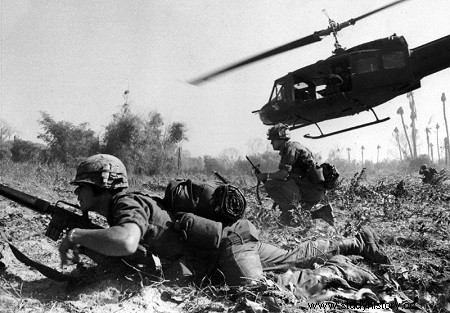
Second Lieutenant Walter J. Marm, Co. A, landed and quickly drove his Sn. in skirmishers in the direction of the place of combat. Almost immediately he took two prisoners and soon after reached the location of the Sn. reserve of the company. B. With her, Marm planned to come to the aid of the Sn. in trouble, when their two commandments of Sn. were caught under heavy fire. The same enemy unit, which had tried to isolate the Sn. from the right of the Co. B, was now apparently seeking to extend this action to the whole Company. and at Sn. of Marm de la Cie. A. While the fire was being answered, Marm tried to evacuate his wounded, but the assigned sergeant realized he could not. In the meantime, the enemy infiltrated through the bed of the dry stream to take Marm from the rear and during this movement encountered the main body of the Company. A coming from the landing area. There followed, in the bed of the stream and on its banks, a wild melee during which a chief of Sn. and a squad leader were among the first killed.
While the Cies. A and B were thus in difficulty, Colonel Moore and the artillery and Air Force officers around him tried to come to their aid. The mortars of the Companies. had long since expended their ammunition supply and the area was covered in dust and smoke. Soldiers pinned to the ground could not discover any valid point that could serve as a landmark and were unable to call for any fire support that was even remotely effective. Airborne officers could do little more than guess the location of friendly positions and bring artillery and air support fires as close to them as safety allowed. The 33rd and 66th North Vietnamese Regts had the situation well in hand and the fire became so violent that they managed to shoot down a Douglas A-1E Skyraider whose pilot was killed. Despite the fact that it was "heating" on the landing area, particularly in the northwestern part near the rump, the doctor of 1st Bn. was able to land there at 2:00 p.m. He went to the command post and, helped by four orderlies, began to treat the wounded who were streaming forward. Warned of the risks, the helicopters, on their fifth trip, brought the rest of the Company to the spot. C and the first elements of the, D. When they had landed, the most seriously wounded were hastily taken on board, but before they could take off a pilot and a gunner were wounded. The commander of the company. D was shot and his radio operator killed before he could unfasten his seat belt. Faced with such fire, Colonel Moore forbade the rest of the Company to land. D
. The commander of this company, having taken the radio from the hands of its killed operator, managed to leave the landing zone, accompanied by four men who dared to brave the fire. They soon found themselves on the right of the two Sns. of the Co. To whom had attacked the enemy group discovered by Marm, while he was trying to surround the Company. B. The Company Commander. D called the rest of his men who were in the landing area, and they came to take up position around him; the company commander. B joined him to warn him that the enemy had already gained his rear, where he and his men had been a little earlier. Suddenly the small command group had to fight on the spot. The enemy fire was formidable, men around them were dying and the commander of the Coy. D and its leader of Sn. mortars were seriously wounded.
It was now nearly 3:00 p.m. and Moore had placed Co. C (whose last elements had been part of the fifth voyage) in the extension of the right flank of Cie. A as blocking element. She rejoined her position with difficulty and had, too, to withstand a violent attack. It looked like the 7th from Cav. was going to suffer the same fate as his ancestors in Little Big Hom.
